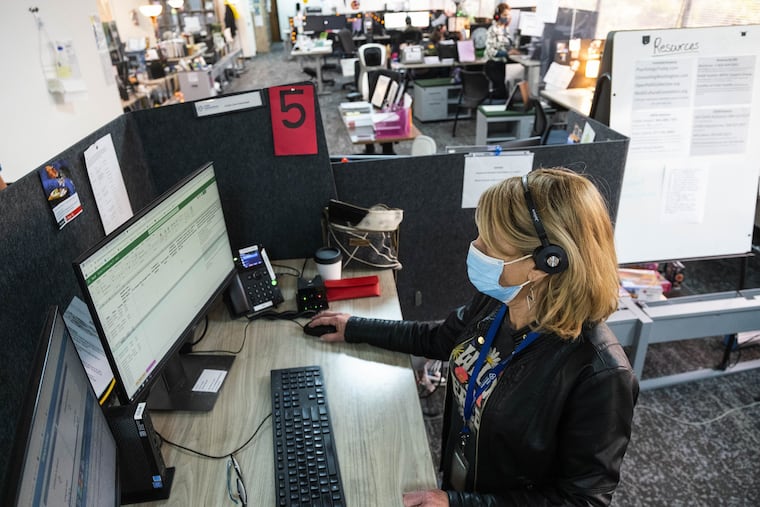What to know about 988, a new national mental health hotline
The new three-digit number is a shorter, more memorable version of the current 10-digit National Suicide Prevention Lifeline 1-800-273-8255 (1-800-273-TALK).

Calling for help in a mental health crisis will now be as simple as remembering a new three-digit hotline.
The 988 crisis number that goes live nationwide on Saturday is designed to make it easier to get the services currently offered through the 10-digit National Suicide Prevention Lifeline number — 1-800-273-8255 (1-800-273-TALK). That line will still be active.
The launch of the new number has been two years in the making. Still, some mental health advocates and providers say many states, including Pennsylvania, don’t have enough resources to respond to an increase in call volume and haven’t secured long-term funding for the line. Others see the push to launch as a catalyst to bolster America’s response to crises and spur more investment in community mental health resources.
Here is what you need to know.
» READ MORE: A new mental health emergency number launches in July. Some hope 988 is a catalyst for bigger change
What is 988?
The new three-digit number is a shorter, more memorable version of the current 10-digit National Suicide Prevention Lifeline 1-800-273-8255 (1-800-273-TALK). Proponents hope that a national three-digit number will allow people to seek help in mental health crises as readily as they dial 911 in other emergencies.
What happens when you call 988?
People should call 988 if they are experiencing any mental or behavioral crisis, regardless of whether they are thinking of harming themselves. A trained counselor will listen and provide assistance.
The majority of calls to crisis lines get resolved on the phone, according to Dale Adair, chief psychiatric officer at the Pennsylvania Department of Human Services. “The person taking the call is able to help the person develop a safety plan,” Adair said in an interview in June. “It’s really about instilling hope.”
When a conversation is not enough, the counselor can help the caller connect with resources. That could include dispatching a mental health crisis-response mobile unit (in areas where those are available), referring to care in the community, or transferring the call to 911.
» READ MORE: Biden administration officials visit Philadelphia to kick off a new national mental health hotline.
Who will answer 988 calls?
Calls to the new hotline will feed into an existing network of call centers that respond to the National Suicide Prevention Lifeline. Pennsylvania has 13 call centers, including one in Philadelphia. New Jersey has five.
Not all calls get answered within the state they are placed. In May, nearly 1 in 3 calls to the lifeline nationally were rerouted out of the caller’s state. Pennsylvania sent 17% of its calls out of state while New Jersey sent 25%.
The new 988 will rely on national backup centers to field calls that don’t get a response within state. The Rutgers University Behavioral Health Care National Call Center in New Jersey will be one of those centers.
“When someone calls 988, based on their area code it will go to a center in their state,” said Ret. Maj. Gen. Mark Graham, executive director of the Rutgers national call center. “If those state centers aren’t capable of handling that call, it then gets automatically rerouted to one of the national centers.”
Are states and call centers ready for the launch?
It depends — both on the state and the public response to the launch of 988.
The law that created 988, the National Suicide Hotline Designation Act of 2020, instructed states to pass legislation to ensure long-term funding for the service. But according to the National Academy for State Health Policy, as of June 29 only 21 states enacted 988 funding laws — Pennsylvania is not among them.
The federal government has been giving out grant funding for states to increase their call center capacity, with $150 million for the project included in the recently enacted Bipartisan Safer Communities Act.
» READ MORE: Firearm suicides outpace homicides. Experts say the Senate gun bill could help.
Supporters hope that 988 will lead to more callers; the question is how fast that happens.
Abby Grasso, the executive director of the National Alliance of Mental Illness in Montgomery County, said the new line could save lives but that the implementation requires adequate funding.
“Our system is already extraordinarily overstretched with a lack of funding for not only mental health services, but paying staff adequate wages to keep people in jobs that are really hard,” she said.
If call volume increases quickly after the launch, states might find themselves unprepared — without the infrastructure to answer calls and without the tools to respond to the needs of the caller.
“There are going to be bumps,” Grasso said.
Are other crisis lines going away?
No. July 16 is the official launch date of 988. That means that any person dialing or texting the number should get a response. However, the current 10-digit National Suicide Prevention Lifeline number (1-800-273-8255) will remain operational for now — and so will county crisis hotlines, such as Philadelphia’s (215-685-6440).
How to find help
- The National Suicide Prevention Talk Line offers help in over 150 languages. Call 1-800-273-8255 or text HELLO to 741741. En Español, marca al 1-888-628-9454. If you're deaf or hard of hearing, call 1-800-799-4889.
- The Philadelphia Suicide and Crisis Center offers guidance and assessment about depression, self harm, hopelessness, anger, addiction, and relationship problems, at 215-686-4420.
- Veterans Crisis Chat is available at 1-800-273-8255 or by text at 838255.
- The Trevor Project offers crisis support to LGBTQ+ youth 25 and under. Call 1-866-488-7386, text START to 678678, or start a chat.